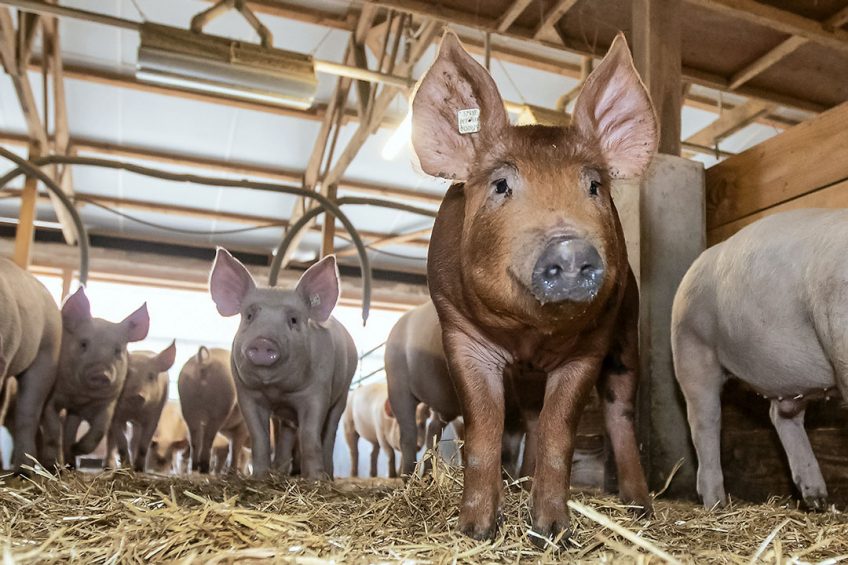Piglet gut health: An economic proposition

A healthy gut is one that is not just free of disease, but one with which the piglet can perform to its full genetic potential, in a sustainable way. The main question is: How can we make sure a gut is as healthy as possible?
A healthy, well-developed piglet will lead to a healthy, well-developed pig. But for this to happen, piglet gastrointestinal (GI) health needs careful consideration. For any animal to grow and develop, it must assimilate the nutrients from either its mother’s milk or its feed into muscle mass.
This process takes place in the GI tract, beginning with the digestion of nutrients. Those nutrients can then be absorbed from the lumen, across the epithelium and into the capillaries to be transported through the blood for use in cellular processes. Critical to digestive and absorptive efficiency is gut health.
Gut health in piglets
The primary question to answer is: What is meant when the topic of discussion is gut health in piglets? A healthy gut is not just free of disease; it is one with which the piglet – and subsequent pig – can perform to its full genetic potential, in a sustainable way. If it is possible to improve the gut health of piglets pre-weaning, then they will be less likely to experience the negative challenges associated with weaning and a changing diet.
The GI tract is a complex organ, made of multiple stages, each with its own morphological structure. One of the most critical areas is the small intestine, as this is the site of nutrient absorption. If villi height and structure are not optimal, then the surface area will not be great enough to allow full uptake of nutrients from the diet in an efficient manner. The small intestine is also critical, as this is the site of a large number of goblet cells. These specialised epithelial cells contain secretory granules that produce mucin and, as a result, are able to produce mucus as an inflammatory response to an insult or challenge.
Gut health and immune function
There is an intrinsic link between gut health and the immune system. Research focused in this area has highlighted the relationship between the microbial population in the gut (microbiome) and immunity. Key to the microbiome is diversity. Bacteria present in the gut help to ferment dietary fibre to short-chain fatty acids, which in turn aids GI health via increasing the number of goblet cells, increasing villi height and decreasing crypt depth.
There is also evidence to suggest that the microbiota aid in metabolic modulation of lipogenesis. As the microbiome consists of “non-self” organisms, it helps to modulate the immune system so that in the event of pathogenic bacteria becoming too prevalent, it can act rapidly and correctly.
Many issues in young piglets are caused by an unjustified immune response to, for example, changing dietary components, leading to inflammatory processes. If it is possible to create a balanced microbial population in the piglet, then it’s also possible to give them the best chance of weaning successfully without compromising performance. Best results are seen when the sow has also been put on the Alltech Gut Health programme, as this ensures that the microbiome being passed down to the piglets is a better profile, giving the piglets the best start in life.

Gut Health Special
Managing gut health is very complex. This special issue covering monogastrics and ruminants highlights specie-specific topics.
A profitable gut
As ever in commercial animal production, it is necessary to distinguish the cost:benefit analysis of the implementation of a gut health programme. Actual performance benefits must be seen in order to make a gut health proposition viable and to ensure the focus of farm managers. Improved gut health in piglets has also been proven in numerous studies to reduce diarrhoea incidence and improve liveability. Supplementation with some products known to improve intestinal health, such as Actigen (Alltech), has been shown to help maintain a healthy gut, thereby reducing the need for antibiotics.
In terms of bottom lines, this is a significant advantage, as it means increased weanling numbers through to the grow/finish stage and reduced days to slaughter. A study focusing on improving gut health in weaned piglets via supplementation through first, creep and starter feeds showed that a healthier gut led to increased end weight, especially through the second phase of 19-42 days. Feed conversion was also significantly improved during this period. This is crucial as it shows the impact that better digestion, absorption and gut health have on energy utilisation and highlights how energy-expensive inflammatory processes can be on a growing pig.

Pig Health Tool
Find out all there is to know about pig health using this unique tool
Facing challenges with immunomodulation
As mentioned above, overactivity of the immune system can affect piglet performance. Immunomodulation can be thought of as the “education” of the immune system, allowing it to respond better to true challenges while ensuring that it does not respond to non-self organisms or particles that do not pose any risk.
Viral and bacterial challenges in pigs, such as PRRSv, can have substantial economic impacts in terms of lost performance through reduction in the number of weaned pigs and impairment of farrowing rates. There is also the financial cost of managing the infection to consider. The immune system forms an integral part of fighting viral infections, through both the innate and adaptive system and production of pro-inflammatory cytokines.
Studies have sought to understand the impact that using products to improve gut health has on challenged animals. In a study conducted by a team around TM Che at the University of Illinois in 2012, results showed that feeding Actigen helped to support piglets’ immune function and thereby reduce the incidence of such economically important challenges. While some viral challenges, such as the recent African Swine Fever epidemic, are too aggressive to be impacted by these measures, it is still important to appreciate how improved immune function can hugely benefit both the animal and profits in pig production.
Overcoming the zinc oxide ban
An important industry challenge that needs to be mentioned is the zinc oxide (ZnO) ban that will come into force in the EU in 2022. Currently, ZnO is used as a preventative measure against post-weaning diarrhoea, although the exact mechanism by which it does this is unknown. Weaning is a disruptive time for the animal. Microbiologically, huge changes are occurring inside the gut, as different species of bacteria now colonise or are outcompeted due to changing feeds and, therefore, changing metabolites. Disruption to the microbiome at that time enables pathogenic bacteria to replicate, such as enterotoxigenic Escherichia coli (ETEC), which can cause post-weaning diarrhoea. E. coli infection is started by adhesion to epithelial cells.
Recent work at Alltech’s Bioscience Centre in Dunboyne, Ireland, has shown that mannan-rich fraction impairs the ability of ETEC to bind and aids in immunomodulation. While more work still needs to be done, this could potentially prove a suitable alternative to ZnO and highlights the importance of optimal gut health on performance and producer economies.











